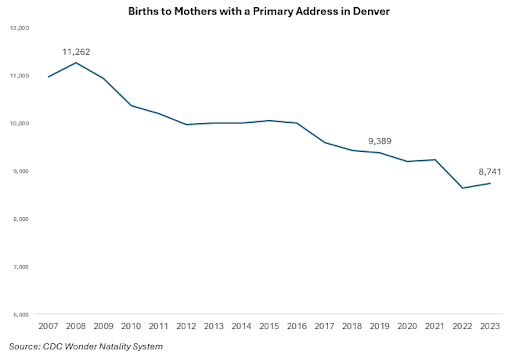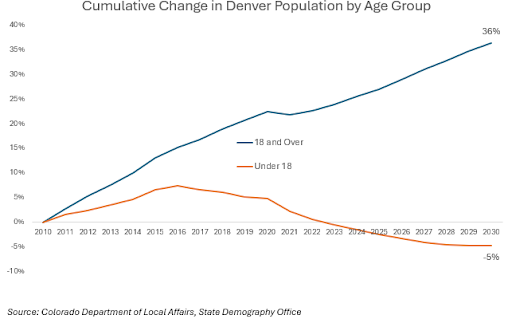Denver Public Schools has an opportunity to set a national example for how to explain declining enrollment and make a strong case for consolidating schools. But time is running short.
In recent weeks, I have attended one of DPS’s regional community meetings focused on school consolidation and have read a wide range of commentary about DPS’s declining enrollment.
Commentary has come from many perspectives: long-time Denver residents, newer families, those who align with some of DPS’s reform efforts or abhor them.
I served as the Executive Director of Planning & Enrollment for DPS from 2011 through 2018, and have created long-term enrollment plans and analyses in more than 20 cities across the country since leaving DPS in 2018.
My goal with this post is to assert a set of facts and opportunities in the hopes it reduces finger-pointing and aligns us all towards making decisions as supportive as possible for our students and community.
Fact #1: Enrollment declines are primarily a result of fewer school-aged children living in Denver, which is outside of the district’s control
Separately from school or district enrollment, an important starting point is looking at the number of children living in Denver and how that has changed. Colorado’s state demographer’s office estimates that the under-18 population in Denver has declined 7.4% since peaking in 2016, resulting in 10,000 fewer children.
Why are there fewer children in Denver? A primary reason is a 22% decline in births since 2008. The birth crisis is not exclusive to Denver. Fertility rates are the lowest in the history of our country along with nearly every other industrialized nation.
I imagine most readers are aware of another key reason there are fewer school-aged children in Denver: the housing affordability crisis the city faces. The lack of affordability makes it challenging for many young families to remain in Denver, so they are more likely to raise their family in a suburban area outside of Denver or even Colorado.
The combination of births and housing are the two most critical factors that are reducing the student population in the city, which has led to declining enrollment.
Fact #2: School choice is not causing enrollment declines
Since 2019 when DPS enrollment recently peaked, charter school enrollment has declined 946 students, or 4.6%. So it’s not just district-run schools experiencing declines. Also during this time, 10 charter schools have closed, many due to low enrollment.
Colorado is an open-enrollment state and DPS is a net-winner in public school choice. Using Colorado Department of Education data, 162 more students (7,105) who live outside Denver choose to transfer into DPS than there are Denver residents leaving for other public schools (6,943 out). If we compare this with 2019 (DPS’s peak enrollment year), 1,193 more students left DPS than came in. So open enrollment is helping DPS, not hurting it.
Finally, while some think families have left the district in droves to attend private school, that’s simply not true. Per CDE, private school enrollment for schools located in Denver has declined 1,239 students since 2019, or 18%. And homeschooling data reported by CDE shows only 65 more Denver students are homeschooled now than in 2019-20. That’s hardly enough to move the needle given improvement in these other areas.
Fact #3: It’s not just Denver, it’s happening everywhere: both locally and nationally
While the education lens for many of us is focused on Denver, as someone whose primarily focus is enrollment planning nationally, I see this topic front-and-center across the country. Cities of all different sizes and geographies are seeing fewer children, ranging from affluent coastal cities like Seattle and San Francisco, to midsize cities like Pittsburgh, San Antonio, and Indianapolis. In our backyard, JeffCo consolidated schools in 2022 in response to an aging population.
Fact #4: Declining student populations is unlikely to improve any time soon and there is little that the district can do about it
While DPS enrollment ticked up last year and this year given the unprecedented influx of students from other countries, those dynamics appear to be slowing here and elsewhere. When fertility rates are historically low, housing prices are historically high, and residential development is heavily focused on downtown area projects that are unlikely to yield students, the trend of fewer children living in the city is likely to persist. This is how you end up with continued growth in the adult population, but fewer children at the same time.
Colorado’s state demographer projects the under-18 population in Denver will decline another 7,000 students by 2030. This is in-line with district enrollment projections that show 5,000 fewer students over the next 5 years.
For DPS, a series of opportunities
It is vital that we have a common understanding of these facts so we can move forward. DPS has a series of opportunities, based on promising practices from around the country. One silver lining of other cities navigating these challenges is gleaning lessons learned from them. We should take advantage of those.
I am organizing these opportunities into three categories: transparency, community empowerment, and staff empowerment.
Transparency on population data: There is a level of mistrust about the population dynamics I am citing here despite being sourced from a range of trusted, non-partisan organizations. Beyond self-reporting information, DPS could have the state demographer present on key population trends to deliver independent expertise and build trust with skeptical stakeholders. This could also include region-level data, because what is happening on the west side of Denver is very different from the growth by the airport.
Transparency on the student experience: School leaders and staff working in small-scale schools are a trusted voice and can help families understand the challenges of under-enrolled schools, including split-grade classrooms, being the only teacher in a grade, lack of enrichment opportunities, or lacking full-time staff in key roles. DPS has shared some anecdotal stories about small schools during the recent community meetings, but having local school leaders share their experience would be valuable.
Further, the district can quantify the magnitude of how the student experience has changed. For example, district-wide, how many students do not have access to a full-time nurse? Or a full-time mental health professional? Or do not have full-time art, music, or PE? Or access to language services or advanced coursework?
These supports are more critical for our children than ever and understanding the current state and future state of fully-staffed schools is important to understanding why these actions are proposed.
Process transparency: Come November 7, DPS should be transparent about how they decide which nearby schools may be receiving students from other schools versus those that will be consolidating. Is it based on enrollment? Nearby population size? Facility size and condition? Academic performance? Building an understanding of these factors is important to establishing a level of trust.
Community and staff empowerment
Community empowerment in a major process such as school consolidations is not just telling families what you are going to do and why with two weeks between notification and a board vote, but giving them the opportunity to co-create elements of the plan moving forward.
In Denver and around the country, we have seen how traumatic the impacts of school closures have been on historically-underinvested communities. If school actions need to happen, we need to do much better listening to families and supporting students.
For example: if school A is consolidated into school B: neither set of families is happy. One is seeing their school close and the other is seeing several hundred new students show up at their formerly-small school and are unlikely to perceive any benefits.
So instead of doing that, why not engage both school communities and co-create what they want the future unified school to look like? There is a long runway between November board decisions and the start of school next August to bring together families, teachers, and students to imagine what they want the new school to look like programmatically, culturally, etc.
Student choice: DPS should offer impacted students an “Opportunity Ticket” or top choice priority to attend another school. This has been a key strategy in Oakland and New Orleans so families are empowered to make decisions if the new school is not the best fit for their student. In certain cases, transportation could be offered, though this obviously involves its own budget and capacity challenges.
Staff empowerment: Across the country, while there are examples of where school consolidations have been executed well, there are far too many where it has gone poorly. One of the key success factors is how staff can lead portions of the plan.
DPS should partner with staff and their representatives to create a Staff Empowerment Plan for those impacted by consolidations. Portions of this plan could be related to commitments to transparency, HR considerations, and avenues for feedback.
Additional elements can be opportunities for staff to lead elements of school unification, given that they know their students and communities much better than central office staff. Engaging and empowering our teachers and school leaders will be critical to having the future schools as supportive and effective as possible for our students.
There is much work to be done. My hope is that our community can harness the energy being spent on finger pointing and mistrust to engage and empower our families so ALL of their children have the thriving experience they deserve.






